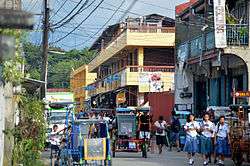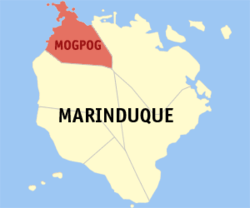Mogpog
| Mogpog | ||
|---|---|---|
| Municipality | ||
| Municipality of Mogpog | ||
 Downtown area | ||
| ||
|
Nickname(s): Gateway to the Heart of the Philippines Home of the Original Moriones | ||
 Map of Marinduque with Mogpog highlighted | ||
.svg.png) Mogpog Location within the Philippines | ||
| Coordinates: 13°29′N 121°52′E / 13.48°N 121.87°ECoordinates: 13°29′N 121°52′E / 13.48°N 121.87°E | ||
| Country |
| |
| Region | Mimaropa (Region IV-B) | |
| Province | Marinduque | |
| District | Lone district of Marinduque | |
| Founded | 1807 | |
| Barangays | 37 (see Barangays) | |
| Government [1] | ||
| • Type | Sangguniang Bayan | |
| • Mayor | Augusto Leo Livelo | |
| • Vice Mayor | Belen Luisaga | |
| • Sangguniang Bayan | ||
| • Electorate | 20,478 voters (2016) | |
| Area [2] | ||
| • Total | 108.06 km2 (41.72 sq mi) | |
| Population (2015 census)[3] | ||
| • Total | 34,043 | |
| • Density | 320/km2 (820/sq mi) | |
| Time zone | UTC+8 (PST) | |
| ZIP code | 4901 | |
| PSGC | 174004000 | |
| IDD : area code | +63 (0)42 | |
| Climate type | Tropical climate | |
| Income class | 3rd municipal income class | |
| Revenue (₱) | 94,872,405.57 (2016) | |
| Native languages | Tagalog | |
| Feast date | May 15 | |
| Patron Saint | Isidore the Laborer | |
| Website |
mogpog | |
Mogpog, officially the Municipality of Mogpog, (Tagalog: Bayan ng Mogpog) is a 3rd class municipality in the province of Marinduque, Philippines. According to the 2015 census, it has a population of 34,043 people.[3]
Barangays
Mogpog is politically subdivided into 37 barangays. [2] Hinanggayon was formerly a sitio of barrio (barangay) Argao; in 1954 it was elevated as a barrio.[4]
- Anapog-Sibucao
- Argao
- Balanacan
- Banto
- Bintakay
- Bocboc
- Butansapa
- Candahon
- Capayang
- Danao
- Dulong Bayan (Poblacion)
- Gitnang Bayan (Poblacion)
- Guisian
- Hinadharan
- Hinanggayon
- Ino
- Janagdong
- Lamesa
- Laon
- Magapua
- Malayak
- Malusak
- Mampaitan
- Mangyan-Mababad
- Market Site (Poblacion)
- Mataas Na Bayan (Poblacion)
- Mendez
- Nangka I
- Nangka II
- Paye
- Pili
- Puting Buhangin
- Sayao
- Silangan
- Sumangga
- Tarug
- Villa Mendez (Poblacion)
The town center or poblacion comprises the barangays of Dulong Bayan, Gitnang Bayan, Market Site, Mataas na Bayan, and Villa Mendez.
History
In 1942, the Japanese troops occupied the town of Mogpog, Marinduque.
In 1945, in the Second World War the liberation of the town of Mogpog, Marinduque, the American and Filipino troops fought against the Japanese Imperial forces during the Battle of Marinduque.
Historically the famous Moriones Festival is said to have originated from Mogpog. Moriones Festival was founded by a Spanish friar Rev. Father Dionisio Santiago the first parish priest of mogpog. This festival is known to be one of the most colorful festivals in Marinduque and the Philippines. It is held in Mogpog and the surrounding areas of Marinduque island.
Demographics
| Population census of Mogpog | ||
|---|---|---|
| Year | Pop. | ±% p.a. |
| 1903 | 6,956 | — |
| 1918 | 6,827 | −0.12% |
| 1939 | 12,132 | +2.78% |
| 1948 | 12,922 | +0.70% |
| 1960 | 18,413 | +2.99% |
| 1970 | 21,980 | +1.78% |
| 1975 | 24,736 | +2.40% |
| 1980 | 26,399 | +1.31% |
| 1990 | 25,337 | −0.41% |
| 1995 | 28,201 | +2.03% |
| 2000 | 31,330 | +2.28% |
| 2007 | 33,341 | +0.86% |
| 2010 | 33,384 | +0.05% |
| 2015 | 34,043 | +0.37% |
| Source: Philippine Statistics Authority[3][5][6][7] | ||
In the 2015 census, the population of Mogpog was 34,043 people,[3] with a density of 320 inhabitants per square kilometre or 830 inhabitants per square mile.
Landmarks

Barangay Balanacan is where the main shipping port is located. It is famous for its large image of Our Lady of Biglang Awa, erected at a top of a shed on a mound of land overlooking the sea.
Not far from the Academy is the town plaza, located at the side right of Marinduque Academy's Main Building, with a great view of a local park, the Municipal Building, and the Trial Court - all of which covers the town public market.
Educational institutions
Secondary
- Argao National High School
- Balanacan National High School
- Butansapa National High School
- Marinduque Academy (Barangay Gitnang Bayan)
- Mogpog NCHS
- Sayao National High School
- Quezon-Roxaz High School (poblacion)
- Puting Buhangin National High School
Primary
- Argao Elementary School
- Balanacan Elementary School
- Bintakay Elementary School
- Bocboc Elementary School
- Butansapa Elementary School
- Capayang-Ino Elementary School
- Danao Public School
- Guisian Elementary School
- Hinadharan Public School
- Hinanggayon Elementary School
- Ino Primary School
- Lamesa Elementary School
- Laon Elementary School
- Magapua Elementary School
- Malayak Elementary School
- Mampaitan Public School
- Mendez Elementary School
- Mogpog Central School
- Nangka Elementary School
- Paye Elementary School
- Pili Elementary School
- Puting Buhangin Elementary School
- Sayao Elementary School
- Silangan Elementary School
- Sumangga Primary School
- Tarug Public School
Notable people from Mogpog
- Ricardo Jamin Cardinal Vidal, Archbishop emeritus of Cebu was born February 6, 1931, in Mogpog.
- Frejan Jimenez Ilagan, Electrical Engineer and a Shipbuilder, the current production manager of Austal Philippines; an Australian shipyard based in Cebu known for designing and manufacturing high performance aluminium vessels specialising in fast ferries and luxury yachts. He was born November 30, 1981, in Puting Buhangin, Mogpog.
Twin towns/cities

References
- ↑ "Municipality". Quezon City, Philippines: Department of the Interior and Local Government. Retrieved 31 May 2013.
- 1 2 "Province: Marinduque". PSGC Interactive. Quezon City, Philippines: Philippine Statistics Authority. Retrieved 12 November 2016.
- 1 2 3 4 Census of Population (2015). "Region IV-B (Mimaropa)". Total Population by Province, City, Municipality and Barangay. PSA. Retrieved 20 June 2016.
- ↑ "An Act to Convert the Sitio of Hinangayon, Mogpog, Marinduque, into a Barrio to Be Known As the Barrio of Hinangayon". LawPH.com. Retrieved 2011-04-11.
- ↑ Census of Population and Housing (2010). "Region IV-B (Mimaropa)". Total Population by Province, City, Municipality and Barangay. NSO. Retrieved 29 June 2016.
- ↑ Censuses of Population (1903–2007). "Region IV-B (Mimaropa)". Table 1. Population Enumerated in Various Censuses by Province/Highly Urbanized City: 1903 to 2007. NSO.
- ↑ "Province of Marinduque". Municipality Population Data. Local Water Utilities Administration Research Division. Retrieved 17 December 2016.
External links
| Wikimedia Commons has media related to Mogpog. |
